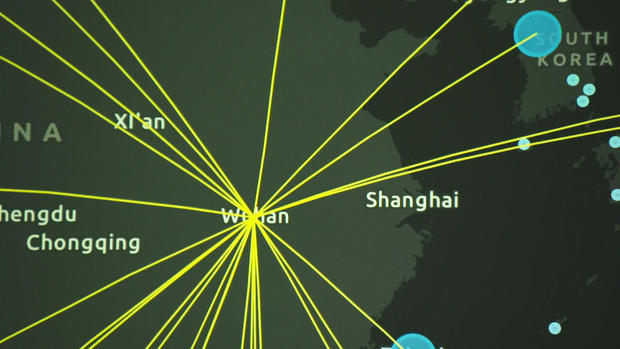It’s telling that, not the US, but a Canadian company, Blue Dot, was among the first to raise the alarm about WuFlu in late December. It uses an Artificial Intelligence algorithm, which pointed to the suspect wetmarket, then lit up as the infection spread therefrom. Anybody could have purchased this program.
The company, Blue Dot, had no clients in the [intellectually incurious?] U.S.
Come to think of it, the US’s formidable Surveillance State should have known about Blue Dot technology, but I guess the program doesn’t appear to harvest personal data, only anonymized data, thus holding no appeal to the opportunistic overlords referred to reverentially as “the U.S. intelligence community.”
Neither does the Blue Dot computer rely on official statements from state actors in tracking an outbreak. It seems to be a mighty analyst and information aggregator. Thus, by the dates mentioned, “Their algorithm was already churning through data, including medical bulletins, even livestock reports, to predict where the virus would go next.’
Canada should certainly have even fewer deaths from coronvirus given that one of its companies had some of this most sophisticated, foolproof methods to track a pandemic before it hits (Canada likely chose not to stop flights from China, even though it knew the score well before our covidiots):
When you’re fighting a pandemic, almost nothing matters more than speed. A little-known band of doctors and hi-tech wizards say they were able to find the vital speed needed to attack the coronavirus: the computing power of artificial intelligence. They call their new weapon “outbreak science.” It could change the way we fight another contagion. Already it has led to calls for an overhaul of how the federal government does things. But first, we’ll take you inside BlueDot, a small Canadian company with an algorithm that scours the world for outbreaks of infectious disease. It’s a digital early warning system, and it was among the first to raise alarms about this lethal outbreak.
It was New Year’s Eve when BlueDot’s computer spat out an alert: a Chinese business paper had just reported 27 cases of a mysterious flu-like disease in Wuhan, a city of 11 million. The signs were ominous. Seven people were already in hospitals.
Almost all the cases came from the city’s sprawling market, where live animals are packed in cages and slaughtered on-site. Medical detectives are now investigating if this is where the epidemic began, when the virus made the leap from animals to us.
… Chinese officials were secretive about what was happening. But BlueDot’s computer doesn’t rely on official statements. Their algorithm was already churning through data, including medical bulletins, even livestock reports, to predict where the virus would go next.
It was also scanning the ticket data from 4,000 airports.
BlueDot wasn’t just tracking flights, but calculating the cities at greatest risk. On December 31, there were more than 800,000 travellers leaving Wuhan, some likely carrying the disease.
In a matter of a just seconds, the Blue Dot computer can “analyze and visualize all this information across the globe in just a few seconds.”
“The virus wasn’t just spreading to east Asia. Thousands of travelers were heading to the United States too. … Most of the travel came into California and San Francisco and Los Angeles. Uh, also, into New York City. And we analyzed that way back on December 31. Our surveillance system that picked up the outbreak of Wuhan automatically talks to the system that is looking at how travelers might go to various airports around Wuhan.”
The virus spread across Asia with a vengeance. BlueDot has licensed access to the anonymized location data from millions of cellphones. And with that data it identified 12 of the 20 cities that would suffer first.
Dr. Kamran Khan: What we’re looking at here are mobile devices that were in Wuhan in the previous 14 days and where are they now across East Asia. Places like Tokyo have a lot of devices, Seoul in South Korea–
Bill Whitaker: So you’re following those devices from Wuhan to these other cities?
Dr. Kamran Khan: That’s correct. I do wanna point out these are also anonymized data. But they allow us to understand population movements. That is how we can understand how this virus will spread.
To build their algorithm, Dr. Khan told us he deliberately hired an eclectic mix: engineers, ecologists, geographers, veterinarians all under one roof. They spent a year teaching the computer to detect 150 deadly pathogens.
Dr. Kamran Khan: We can ultimately train a machine to be reading through all the text and picking out components that this is talking about an outbreak of anthrax and this is talking about the heavy metal band Anthrax. And as you do this thousands and thousands and thousands of times, the machine starts to get smarter and smarter.
Bill Whitaker: And how many different languages does the computer understand?
Dr. Kamran Khan: So it’s reading this currently in 65 languages, and processing this information every 15 minutes, 24 hours a day. So it’s a lotta data to go through.
Within two hours of detecting the outbreak on December 31, BlueDot had sent a warning of the potential threat to its clients: public health officials in 12 countries, airlines and frontline hospitals, like Humber River in Toronto.
The US was too dumb and callous to buy Blue Dot’s AI program.
MORE: “The computer algorithm that was among the first to detect the coronavirus outbreak.”



 print
print